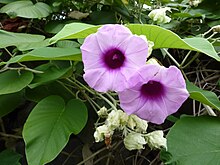Argyreia nervosa
This article needs additional citations for verification. (April 2010) |
| Argyreia nervosa | |
|---|---|

| |
| Argyreia nervosa flowers (enlarge) | |
| Scientific classification | |
| Kingdom: | Plantae |
| Clade: | Tracheophytes |
| Clade: | Angiosperms |
| Clade: | Eudicots |
| Clade: | Asterids |
| Order: | Solanales |
| Family: | Convolvulaceae |
| Genus: | Argyreia |
| Species: | A. nervosa
|
| Binomial name | |
| Argyreia nervosa | |
| Synonyms[2] | |
|
Argyreia speciosa (L.f.) Sweet | |
Argyreia nervosa is a perennial climbing vine native to the Indian subcontinent and introduced to numerous areas worldwide, including Hawaii, Africa, and the Caribbean. Though it can be invasive, it is often prized for its aesthetic and medicinal value.[3] Common names include Hawaiian baby woodrose, adhoguda अधोगुडा or vidhara विधारा (Sanskrit), elephant creeper and woolly morning glory. Its seeds are known for their powerful entheogenic properties, greater or similar to those of Ipomoea species, with users reporting significant psychedelic and spiritual experiences.[4][5] The two botanical varieties are A. n. var. nervosa described here, and A. n. var. speciosa, the roots of which are used in Ayurvedic medicine.[3][6]
Argyreia nervosa contains various ergoline alkaloids such as ergine.[7] A study reported stereoisomers of ergine to be found in the seeds at a concentration of 0.325% of dry weight.[8] Two modern studies from a team of researchers also revealed lysergic acid,[9] methylergometrine (syn. lysergic acid butanolamide), methysergide, lysergylalanine, and suspected, unidentifed ergopeptines.[10] A study of the related Ipomoea tricolor showed that ergoline concentrations in the leaves are 12-fold lower than that of the seeds.[11]
History
[edit]While seeds of other Convolvulaceae, specifically Ipomoea corymbosa (ololiuhqui) and Ipomoea tricolor (tlitliltzin), were used in shamanic rituals of Latin America for centuries, A. nervosa was not traditionally used for this purpose. Its properties were first brought to attention in the 1960s.[citation needed]
Cultivation
[edit]Where temperatures fall below 13 °C (55 °F), Argyreia nervosa is grown in a warm greenhouse. Elsewhere, it is grown on arbours, pergolas, walls, or trees. It is often grown professionally under glass in a loam-based potting compost (John Innes No. 3) in full light, and watered freely from spring to autumn, with a balanced liquid fertilizer applied monthly and reduced water in winter. It is grown outdoors in moderately fertile, moist but well-drained soil in full sun. Pruning is done in late winter.[12]
Glycosides
[edit]
- Argyroside, (24R)-ergost-5-en-11-oxo-3β-ol-α-D-glucopyranoside, a steroidal glycoside unique to Argyreia nervosa[13]
Ergolines
[edit]| Ergoline alkaloids of known percentage | ||
|---|---|---|
| Compound name | Percentage of dry seed weight constituted | Chemical structure |
| Isoergine | 0.188% | 
|
| Ergine | 0.136% | |
| Ergometrine | 0.049% | 
|
| Lysergic acid hydroxyethylamide | 0.035% | 
|
| Isolysergic acid hydroxyethylamide | 0.024% | |
| Elymoclavine | 0.022% | 
|
| Ergometrinine | 0.011% | 
|
| Chanoclavine | 0.016% | 
|
| Ergoline alkaloids of unknown percentage | ||
|---|---|---|
| Compound name | Chemical structure | |
| Agroclavine | 
| |
| Festuclavine | 
| |
| Chanoclavine II | 
| |
| Lysergene | 
| |
| Lysergol | 
| |
| Isolysergol | ||
| Setoclavine | 
| |
| Isosetoclavine | ||
Hydroxycinnamic acids
[edit]| Hydroxycinnamic acids | ||
|---|---|---|
| Compound name | Chemical structure | |
| Caffeic acid | 
| |
| Ethyl caffeate | 
| |
Fatty acids
[edit]| Fatty acids | ||
|---|---|---|
| Compound name | Chemical structure | |
| Myristoleic acid | 
| |
| Myristic acid | ||
| Palmitic acid | ||
| Linoleic acid | ||
| Linolenic acid | ||
| Oleic acid | 
| |
| Stearic acid | ||
| Nonadecylic acid | ||
| Eicosenoic acid | ||
| Heneicosylic acid | ||
| Behenic acid | ||
| 12-methylmyristic acid | ||
| 15-methylstearic acid | ||
| Glycosides of fatty acids | |
|---|---|
| Fatty acid | Chemical structure |
| Palmitic acid | |
| Oleic acid | 
|
| Stearic acid | |
| Behenic acid | |
| Linoleic acid | |
| Linolenic acid | |
Entheogen
[edit]
Certain New Age sources claim that, according to 'various oral histories' Huna shamans used the powdered seeds to prepare an entheogenic drink.[14] This is unlikely to reflect an authentic practice having once formed a part of traditional Hawaiian Religion,[15] given that Huna has been widely discredited as a culturally appropriative New Age religion invented by Max Freedom Long.[16] The seeds of Argyreia nervosa can produce psychoactive effects, but it has not yet been demonstrated satisfactorily that their use as an entheogen predates the various countercultural movements of the 1960s.[15] Given that A. nervosa is not native to Hawaii, having been introduced there from India, any Hawaiian practices involving it are unlikely to be of any antiquity. It cannot, however, be ruled out that the plant may have been utilised as an intoxicant in its native India at some time in the past, although evidence for this (if present) has not yet come to light.[15] The seeds of A. nervosa contain ergot alkaloids varying considerably in concentration with LSA weight ranging between exactly similar looking seeds from 3 μg to 34 μg (avg 17 μg).[17] However, in its effects, LSA is about one tenth as potent as its cousin LSD, making a threshold dose level for LSA (D-Lysergic Acid Amide) about 500 μg.[18] The psychoactive effects of the seeds may therefore be due to other alkaloids present in them and the safe and effective dose may be difficult to predict.
Uses in the traditional medicine of India
[edit]While he does not claim there to be any evidence for the use of the seeds of A. nervosa as a traditional entheogen in its native India, Christian Rätsch does describe some interesting traditional uses of the root of the plant in Ayurveda somewhat suggestive of effects upon the CNS:[15]
The root is regarded as a tonic for the nerves and brain and is ingested as a rejuvenation tonic and aphrodisiac to increase intelligence.[15]
Other traditional uses are in the treatment of gonorrhea, strangury, chronic ulcers, diabetes, anemia, and cerebral disorders. The plant is also used as appetizer, brain tonic, cardiotonic, and aphrodisiac. It possesses anti-inflammatory, immunomodulatory, antibacterial, antiviral, and antifungal activities [19]
References
[edit]- ^ Glossary Of Indian Medicinal Plants
- ^ "Argyreia nervosa". Germplasm Resources Information Network. Agricultural Research Service, United States Department of Agriculture. Retrieved 2010-11-10.
- ^ a b "Medicinal uses and biological activities of Argyreia speciosa Sweet (Hawaiian Baby Woodrose) — An Overview". Indian Journal of Natural Products and Resources: 286–291. September 2011.
- ^ E. Al-Assmar, Sami (1999). "The Seeds of the Hawaiian Baby Woodrose Are a Powerful Hallucinogen". Arch Intern Med. 159 (17): 2090. doi:10.1001/archinte.159.17.2090 (inactive 2024-11-13). PMID 10510998.
{{cite journal}}: CS1 maint: DOI inactive as of November 2024 (link) - ^ Paulke, Alexander; et al. (2015). "Studies on the alkaloid composition of the Hawaiian Baby Woodrose Argyreia nervosa, a common legal high". Forensic Science International. 249: 281–293. doi:10.1016/j.forsciint.2015.02.011. PMID 25747328.
- ^ The Ayurvedic Pharmacopoeia of India, part 1, vol. 5. Government of India, Ministry of Health and Family Welfare, Department of Ayush. http://www.ayurveda.hu/api/API-Vol-5.pdf
A. nervosa entry: page 16
“T.L.C. of methanolic extract of the roots on precoated silica gel G plate using methanol - chloroform (20 : 80) showed a blue fluorescent spot under UV (365nm) along with number of other spots of very weak intensity. Due to the presence of very negligible amount of alkaloids in the roots these could not be isolated.” (p. 17) - ^ Halpern, J.H. (2004). "Hallucinogens and dissociative agents naturally growing in the United States". Pharmacology & Therapeutics. 102 (2): 131–138. doi:10.1016/j.pharmthera.2004.03.003. PMID 15163594. S2CID 30734515.
Although LSD does not occur in nature, a close analogue, lysergic acid amide (LSA, ergine) is found in the seeds of Argyreia nervosa (Hawaiian baby woodrose)
- ^ Chao JM, Der Marderosian AH (1973). "Ergoline alkaloidal constituents of Hawaiian baby wood rose, Argyreia nervosa (Burmf) Bojer". J. Pharm. Sci. 62 (4): 588–91. doi:10.1002/jps.2600620409. PMID 4698977.
- ^ Paulke, Alexander; Kremer, Christian; Wunder, Cora; Wurglics, Mario; Schubert-Zsilavecz, Manfred; Toennes, Stefan W. (2014-09-01). "Identification of legal highs – Ergot alkaloid patterns in two Argyreia nervosa products". Forensic Science International. 242: 62–71. doi:10.1016/j.forsciint.2014.06.025. ISSN 0379-0738
“Additionally the presence of the ergot alkaloid diastereomers chanoclavine I and II was assumed in DF (cf. Fig. 6) together with traces of lysergic acid and the isobars lysergol, isolysergol, elymoclavine, molliclavine, setoclavine, or isosetoclavine.” (3.1. Mass spectrometry data, p. 65)
“Indications of traces of [M+H]+ = 255.15 0.01 corresponding to lysergol/isolysergol, elymoclavine, setoclavine/isosetoclavine or molliclavine as well as [M+H]+ = 269.13 0.01 corresponding to lysergic acid were only obtained in the DF extracts and the resolution and the quality of the EICs and product spectra was poor. Therefore, the presence of lysergol/isolysergol, elymoclavine, setoclavine/isosetoclavine, molliclavine or lysergic acid cannot be excluded, but proof cannot be provided and additional research will be necessary.” (3.1. Mass spectrometry data, pages 65 & 68){{cite journal}}: CS1 maint: postscript (link) - ^ Paulke, Alexander; et al. (2015). "Studies on the alkaloid composition of the Hawaiian Baby Woodrose Argyreia nervosa, a common legal high". Forensic Science International. 249: 281–293. doi:10.1016/j.forsciint.2015.02.011. PMID 25747328
“On the other hand, methylergometrine, methysergide, and lysergylalanine were detected, which have not yet been reported as compounds of Argyreia nervosa seeds. Furthermore, some high molecular weight ergot alkaloid derivatives and hydroxyalanine derived ergopeptide fragments could be observed at various retention times (c.f. chapter 3.1). Altogether, lysergylalanine, the high molecular weight ergot alkaloids and the hydroxyalanine derived ergopeptide fragments strongly suggest the presence of ergopeptides in Argyreia nervosa. However, due to the disadvantage of the applied APCI technique for peptide analysis (c.f. chapter 3.1) additional research (e.g. ESI-HRMS/MS) will be necessary to verify this assumption and to elucidate the structure of the ergopeptides.” (3. Results and discussion, p. 283){{cite journal}}: CS1 maint: postscript (link) - ^ Nowak, Julia; Woźniakiewicz, Michał; Klepacki, Piotr; Sowa, Anna; Kościelniak, Paweł (May 2016). "Identification and determination of ergot alkaloids in Morning Glory cultivars". Analytical and Bioanalytical Chemistry. 408 (12): 3093–3102. doi:10.1007/s00216-016-9322-5. ISSN 1618-2642. PMC 4830885. PMID 26873205"ergine and ergometrine concentration is 12-fold lower in plant samples than in seeds." Analysis of IP-HB2 young plants
{{cite journal}}: CS1 maint: postscript (link) - ^ Brickell, Christopher (2016). Royal Horticultural Society: A-Z Encyclopedia Of Garden Plants. Great Britain: Dorling Kindersley. p. 110. ISBN 9780241239124.
- ^ Rahman, A.; Ali, M.; Khan, N. Z. (2003). "Argyroside from Argyreia nervosa Seeds". ChemInform. 34 (21): 60–2. doi:10.1002/chin.200321168. ISSN 0931-7597. PMID 12622256.
- ^ "Entheology.org - Preserving Ancient Knowledge". www.entheology.org. Archived from the original on 2006-05-02. Retrieved 2017-10-24.
- ^ a b c d e Rätsch, Christian (2004). The Encyclopedia of Psychoactive Plants: Ethnopharmacology and Its Applications. Park Street Press, U.S. ISBN 978-0892819782.
- ^ Chai, Makana Risser (2011). "Huna, Max Freedom Long, and the Idealization of William Brigham" (PDF). The Hawaiian Journal of History. 45. Archived from the original (PDF) on 2021-01-18.
- ^ Paulke, Alexander; Kremer, Christian; Wunder, Cora; Wurglics, Mario; Schubert-Zsilavecz, Manfred; Toennes, Stefan W. (2014). "Identification of legal highs--ergot alkaloid patterns in two Argyreia nervosa products". Forensic Science International. 242: 62–71. doi:10.1016/j.forsciint.2014.06.025. ISSN 1872-6283. PMID 25036782.
- ^ Wasson RG, Hofmann A, Ruck CA, Webster P (2008-11-25). The Road to Eleusis: Unveiling the Secret of the Mysteries. Berkley, California: North Atlantic Books. ISBN 9781556437526.
“The effective dose of lysergic acid amide is 1 to 2 mg by oral application.” Albert Hofmann. 2. A Challenging Question and My Answer, p. 40 - ^ Bharati, A. J.; Bansal, Y. K. (2014). "Phytochemical investigation of natural and in vitro raised Vṛddhadāruka plants". Ancient Science of Life. 34 (2): 80–84. doi:10.4103/0257-7941.153463. PMC 4389397. PMID 25861141.
External links
[edit]- PLANTS database entry
- Dressler, S.; Schmidt, M. & Zizka, G. (2014). "Argyreia nervosa". African plants – a Photo Guide. Frankfurt/Main: Forschungsinstitut Senckenberg.
